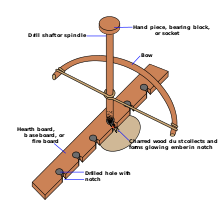A bow drill is a simple hand-operated type of tool, consisting of a rod (the spindle or drill shaft) that is set in rapid rotary motion by means of a cord wrapped around it, kept taut by a bow which is pushed back and forth with one hand. This tool of prehistoric origin has been used both as a drill, to make holes on solid materials such as wood, stone, bone, or teeth, and as a fire drill to start a fire.[1][2][3]

The spindle can be held into a fixed frame, or by a hand-held block (the hand piece or thimble) with a hole into which the top of the shaft is inserted. Some lubricant should be used to reduce friction between these two parts, otherwise, it could lead to some trouble when doing it too fast. A popular campcraft book of 1920 attributed this invention to the Inuit.[4] In Mehrgarh (Pakistan) it has been dated between the 4th-5th millennium BCE.[5]
The string of the bow is wrapped once around the spindle, so that it is tight enough not to slip during operation. In a variation called the Egyptian bow drill, the cord is wound around the shaft multiple times, or is fixed to it by a knot or a hole.[citation needed]
The strap drill is a simpler version, where the bow is absent and the cord is kept taut by pulling the ends with both hands, while moving them left and right at the same time. In the absence of a frame, the thimble is shaped so that it can be held with the chin or the mouth.[citation needed]
The bow lathe used for traditional woodturning uses the same principle as the bow drill.
- ^ Cite error: The named reference
hodge2003was invoked but never defined (see the help page). - ^ Cite error: The named reference
ulrich2007was invoked but never defined (see the help page). - ^ Cite error: The named reference
garg2012was invoked but never defined (see the help page). - ^ Cite error: The named reference
beard2014was invoked but never defined (see the help page). - ^ Kulke, Hermann; Rothermund, Dietmar (2004). A History of India. Abingdon, Oxfordshire: Routledge. p. 22. doi:10.4324/9781315628806. ISBN 0415329205.